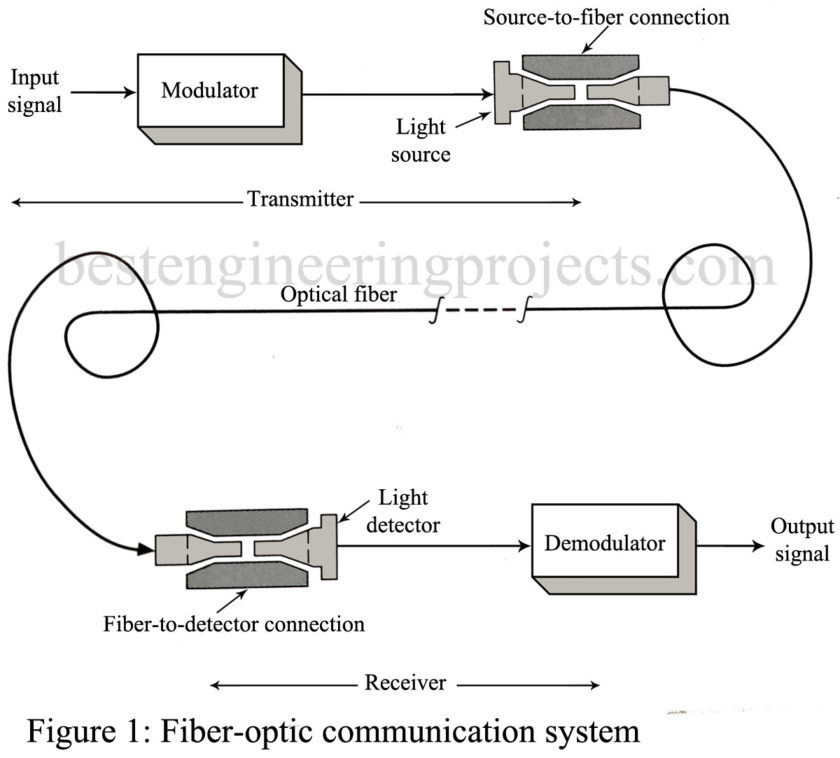In the article Introduction and Advantages of Optical Communications, we will discuss optical communications and their advantages.
Introduction of Optical Communication:
Recent advances in the development and manufacture of fiber-optic systems have made them the latest frontier in the field of communications. They are being used for both military and commercial data links and have replaced a lot of copper wire. Their use in telecommunications is extensive. They are also expected to take over much of the long-distance communication traffic now handled by satellite links.
A fiber-optic communications system is surprisingly simple, as shown in Figure 1. It is comprised of the following elements:
- A fiber-optic transmission cable to carry the signal (in the form of a modulated light beam) a few feet or several miles. The cable may be a single, hair-like fiber or a small bundle of hundreds of such fibers.
- A source of visible or invisible infrared radiation—usually a light-emitting diode (LED) or a solid-state laser—that can be modulated to impress data or an analog signal on the light beam.
- A photosensitive detector to convert the optical signal back into an electrical signal at the receiver. The most often used detectors are p-i-n or avalanche photodiodes.
- Efficient optical connectors at the light source-to-cable interface and the cable-to-photodetector interface. These connectors are also critical when splicing of the optical cable is required due to excessive loss that can occur at connections.
- Standard communications electronics before the light source and following the photodetector.
The optical waveguide propagates the light signal in a fashion similar to the standard metallic waveguide. The light wave travels down the glass fiber by constant reflection off its sidewalls. Thus, the trapping of light in fiber results from the phenomenon of total internal reflection (TIR).
Advantages of Optical Communications
The advantages of optical communications links compared to waveguides or copper conductors are enormous. Included are the following:
- Substantially lighter weight and smaller size: The U.S. Navy replaced conventional wiring on the A-7 airplane that transmitted data between a central computer and all its remote sensors and peripheral avionics with an optical system. In this case, 224 ft of fiber optics weighing 1.52 lb replaced 1900 ft of copper wire weighing 30 lb.
- Immunity to electromagnetic interference (EMI): External electrical noise does not affect energy at the frequency of light.
- Virtual elimination of crosstalk: The light on one glass fiber does not interfere with the light on an adjacent fiber. This is analogous to one standard waveguide close to another. Crosstalk can result from two adjacent copper wires, however.
- Lower signal attenuation than other propagation systems: Typical attenuation figures of a 1-GHz bandwidth signal for optical fibers is 0.03 dB per 100 ft compared to 4.0 dB for both RG-58/U coaxial cable and an X-band waveguide.
- Extremely wide system bandwidths: The intelligence is impressed by varying the light’s amplitude. Since the best LEDs have a 5-ns response time, they provide a maximum bandwidth signal of about 100 MHz. Using laser light sources, however, bandwidths of up to 10 GHz are possible with single glass fiber. The amount of information multiplexed on such a system is indeed staggering. The higher the carrier frequency in a communication system, the greater its potential signal bandwidth. Since fiber-optics systems have carriers at 1013 to 1014 Hz compared to radio frequencies of 106 to 109 Hz, signal bandwidths are potentially many times greater.
- Lower cost: Optical-fiber costs are continuing to decline while the cost of copper is increasing. Many systems are now cheaper with fiber, and that trend is accelerating.
- Conservation of the earth’s resources: The world’s supply of copper (and other good electrical conductors) is limited. The principal ingredient in glass is sand, and it is cheap and in virtually unlimited supply.
- Safety: In many wired systems, the potential hazard of short circuits requires precautionary designs. Additionally, the dielectric nature of optic fibers eliminates the spark hazard.
- Corrosion: Since glass is inert, the corrosive effects of certain environments are not a problem.
